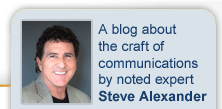| |
| |
Posts Tagged ‘Media Training’
Posted February 18th, 2012 by The Steve Alexander Group
In the communications world, we’re constantly looking for those anecdotes and stories that help others learn about the importance and challenges of communicating to our audiences. One recently occurred with a little friend of mine (‘little’ meaning 10 years old!) in trying to help her solve a problem. It helped underscore the importance of using language that has meaning to the receiver, and of making sure our communications are audience-focused.
She called me, as a family friend, from her mom’s mobile phone to tell me they were having trouble with their new television and video-streaming reception (not that I’m an expert by any stretch, however, I’m a practiced tinkerer and have some talent in unexpected areas beyond my day job!). It seemed like nothing was working. Because they had one of those full-service, one-provider arrangements, I asked if the house phone worked. She didn’t know (and rarely uses it), so I asked her to pick up the phone and listen for the dial-tone. Her response was startling!
“What’s a dial-tone?”
At first I thought she was teasing me (something she learned from me and at which she is now well-practiced). I repeated my question, and asked if she could hear the dial-tone on the house phone. For context, this is someone with an iPad, iPod and notebook computer, and who uses her mom’s mobile phone for voice communication. Once she knows your eddress, you’re a regular in her ‘Contacts’ list, and are sure to be updated on her life activities via email, texts, etc.
I was a bit taken aback and started to describe what a dial-tone was when I realized she was of a generation that had no real experience with the concept, and that I’d lost my ‘audience’ because I was unable to speak in a language and with words, symbols and substance that she understood. In my inability to explain and attempt to grasp for comparisons, this thought came to me: How often do we communicate in a language, at a time, with an emotion or intent that makes complete sense to us, but leaves our audiences, our listeners, totally disconnected (pardon the pun!)?
We act based on what WE think WE know, rather than taking the time to understand what our audiences/listeners know and need. It’s a focal point of a lot of the professional coaching I do as well. Often my counsel (when clients present a challenge in communicating with someone) is to slow down, think about the person they are communicating to, and ask them to apply the old ‘put yourself in their chair’ exercise. For example, what is that person thinking? What experiences do they bring to the conversation? What are their needs, wants, desires; fears, apprehensions, anxieties? Apply the “Seek first to understand, rather than to be understood” lesson. In other words, focus on your audience.
When we train speakers, it’s the same advice. Ask, why are folks sitting in their chairs listening to me? Why are they there? What do they want? (Rather than the classic speaker’s mistake of asking: What do I want to tell them?)
This little 10-year old is pretty sharp, and eventually I was able to help her with her problem. It made me aware that a mobile-phone generation may NEVER hear a dial-tone, and that word, like so many others, illustrates the need for changing language, symbols and substance as we communicate to others who may have a different perspective, background, culture, history, etc. than we do. We need to understand what others need and want from the communication, presentation, meeting, or other interaction they’re having with us, and help understand their ‘language,’ and where they are coming from in the midst of their challenge, or solution-seeking.
And remember, we may be speaking ‘dial-tone,’ and they may be speaking ‘mobile phone,’ and we both may lose out on making an important connection!
Posted October 10th, 2010 by Steve Alexander
We have the tendency to think of others from our own world view, in other words, when we think about the messages we believe our organizations need to communicate, we get caught up in our own world, our internal language and what we know. We forget – most of those with whom we come in contact everyday do not share our experiences, including education, opportunity, social and family background, culture, you name it. As a result, we communicate from where we feel comfortable and are knowledgeable and experienced. As a result, we don’t reach or connect with our audience.
To reach an audience of customers, citizens, taxpayers, employees, patients, whomever your audience might be, the most effective communications start with getting out of our own parochialism. Tough to do when you’re used to using certain language, acronyms and images every day in your own work world.
Clients often ask us, “Why can’t we just tell them how important this is?” Well, that’s great if you have unlimited resources and can populate every place they get information in a non-stop, consistent way with what you think should be important to them! Even then you’re unlikely to get them to pay attention.
Ask yourself this simple question, “What was the last TV commercial I remember, including the product, the message and images?” Yet, here’s where companies spend a small fortune seeking your attention and, as my friend and colleague, Dan Kully of Laguens Kully Klose Partners always reminds me, have done some of the most extensives audience research on the planet. Tough to remember that last commercial, huh? And you’re probably even saying to yourself, “I don’t even watch that much TV!” Ah, and that makes you quite unlike your audience… your employees, customers, patients, etc.
Just check some of the statistics on how much TV people watch and that alone will give you a little clue. According to the A.C. Nielsen Co., the Americans watch more than four hours of TV each day (or 28 hours/week, or two months of nonstop TV-watching per year). For the average 65-year old, that’s about nine years of their life. This is not a discussion pro or con for TV watching, just pointing out that if those are not your habits, then by the same token, you’re not like most of your audiences.
Your assignment this week: Make a list of all the acronyms you use in your industry, profession, etc. and when you’re at your favorite restaurant, retail store or wherever you can ask the question without getting arrested, ask your server, clerk, etc. what the acronyms mean; just limit your self to about five of them. I think you can anticipate the results.
So, next time you and your organization decide you want to talk to the public, your audience, invest some time in asking who they are, where they come from ideologically, experientially, culturally, economically, etc. Get out of your own comfort zone, your own space. You’ll be surprised at the result.
Let me know what you learn and how you do. Especially with your assignment!
Posted February 24th, 2010 by Steve Alexander
The Steve Alexander Group celebrates its 10 year anniversary with the launch of its new Web site at alexanderpa.com. We welcome you to take a test drive to see what you think. If you like the experience, let us know. Your feedback about what works and what could be done better is part of our commitment to improvement. After all, the site is about you, our clients, colleagues and supporters, and the chance we’ve had to serve on behalf of the good work these many individuals and organizations do for their clients, customers and constituents.
And, of course, if our service lines, strategic partners and client testimonials inspire you to contact us, we’d love to have the opportunity to see if we can help you meet your challenges, contribute to your success and collaborate with you as you grow in the coming year.
We’ll also be offering tips, tidbits, advice and insights to challenge your thinking, and stretch yourself, your employees and your organization through our blog. We invite you to opt-in so you can keep abreast of the latest information, articles, resources and other opportunities that can benefit you.
So, thanks for taking the time to experience our new home. We look forward to continuing our work, and our commitment to the best professional services in an array of areas where we can provide value and collaborate in the coming years.
Posted January 21st, 2010 by Steve Alexander
Another site from our ongoing list of good things we’ve found on the ‘net.
News You Can Use – If you’re in California and not checking out Rough and Tumble, you’re not really reading the news each day; this site tallies and prepares all the California-profiled news for you long before you sip your first cup o’ Joe. It’s a great aggregator of sites with political, economic, education, environmental, healthcare and other topics of interest. And, with California a big trend-setting state, it’s useful to see what’s happening and how it might affect other parts of our nation, and our world.
Posted December 14th, 2009 by The Steve Alexander Group
Interesting opinion piece in the Los Angeles Times about how the American public gets its news and information. What caught my attention, and is a growing theme, is how ideologically partisan the news has become. Event more interesting is how the “middle,” as it’s described in the piece (meaning news that seeks to balance both sides of an ideological position), comes in last out of the two major views (liberal vs. conservative) in the televison news category. This would probably make Edwin R. Murrow shake in his grave, and was predicted in the closing scene of the movie, Good Night, and Good Luck, as something to be concerned about. That time has surely come.
For our fellow public opinion research aficionados, enjoy the piece and let us know your thoughts!
Return to Top
|
|
|
|




